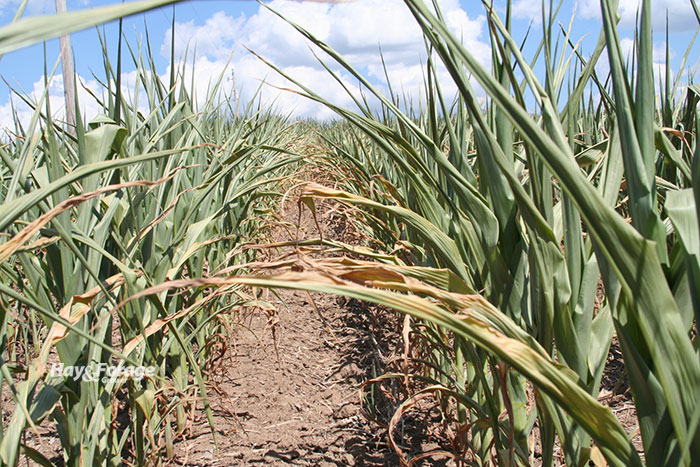
Drought conditions persist across the country, and farmers are feeling the heat. As limited rainfall threatens to thwart grain fill in corn, it might be necessary to harvest some fields as a forage.
University of Nebraska Extension Educators Brad Schick and Jenny Rees and Beef Systems Specialist Mary Drewnoski note that cornstalks can be baled, chopped, or grazed; however, drought-stressed corn may contain high levels of nitrates. These compounds replace oxygen in animals’ hemoglobin, leading to suffocation and even death.
Nitrates accumulate in lower portions of a plant, and some parts of a field have higher nitrate levels than others. In addition to gathering samples and testing forage, the extension specialists offer the following advice for different methods of harvesting corn stover.
Silage. Cut stalks to a height of 6 to 8 inches when plant moisture is about 65% to 70%. Then, apply an inoculant to silage to maintain quality and prevent spoilage while in storage. During the ensiling process, nitrate levels can be reduced by as much as 50% when these compounds are converted to nitrous oxide and escape the pile as a gas.
“Proper ensiling technique is key to success,” the authors note. “Before using silage in a ration, it’s a good idea to test it for moisture, crude protein, total digestible nutrients, and nitrate content to allow for proper formulation,” they add.
Baleage. Making baleage can lower nitrate levels in forage as well. Harvest corn and dry forage down to 45% to 55% moisture. Then, bale the stalks and wrap them with at least six layers of plastic that is 1 mil thick.
Dry hay. Unlike the ensiling process, drying hay does not lower nitrate levels. Therefore, cornstalks that will be baled must be cut at least 8 to 12 inches above the ground to avoid parts of the plant with the highest nitrate concentrations. Allow forage to dry until it is approximately 15% moisture before baling, and dilute hay with other feedstuffs if nitrates reach toxic levels.
Grazing. “If grazing drought-stressed corn, limit access to the field from both a grain and nitrate risk standpoint,” the specialists advise. “Seasoned cows will seek out the corn ears before forage, meaning the cows will have a high grain diet and an increased risk of acidosis.”
Prior to grazing, feed cattle 2 to 3 pounds of grain per day, and work up to 10 to 15 pounds of grain per day over the course of two weeks. Continue to feed hay before turning animals out to the pasture to limit grain and nitrate consumption.
Implement a strip grazing approach to further mitigate nitrate poisoning and grain intake. Start by grazing cornstalks that are low in nitrates and proceed to areas that may be higher risk. Ensure cattle have plenty of water available, and provide poloxalene as an additional safety measure.
Greenchop. Chopped forage can be fed to livestock without being ensiled, but this must be done immediately after harvest. “If greenchop is left in the bunk or on the wagon, it can heat up and nitrate will be converted to nitrite,” the specialists caution. “Nitrite is 10 times as toxic as nitrate when fed to animals. Therefore, it is better to feed greenchop two to three times a day.”

Amber Friedrichsen is the 2022 Hay & Forage Grower editorial intern. She currently attends Iowa State University where she is majoring in agriculture and life sciences education-communications and agronomy. Friedrichsen grew up on her family’s diversified crop and livestock farm near Clinton, Iowa.

